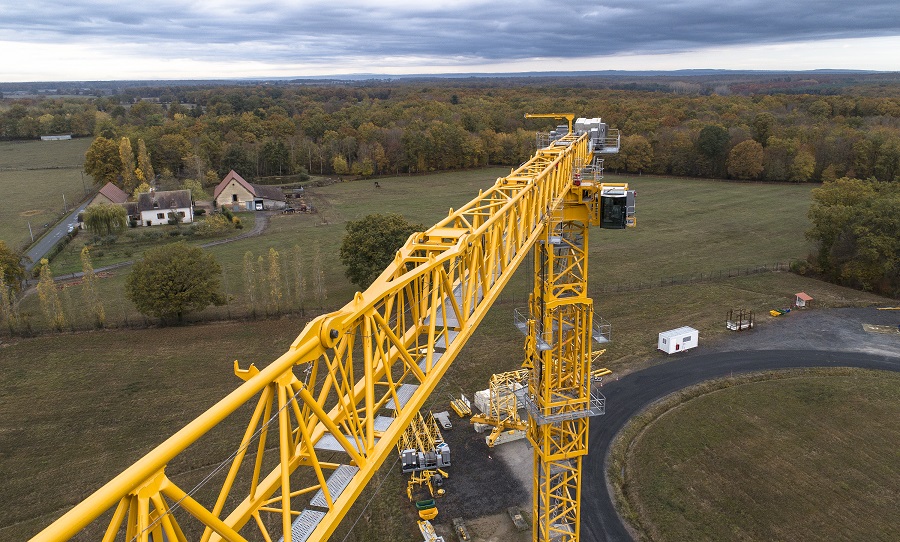Grove is one of the oldest crane brands still flourishing in the Middle East, but today’s its rough-terrain machines are more likely to be built at its plant in Italy than its U.S. facility. David Semple, senior vice president at Manitowoc for the Middle East, India, Russia and Africa, explains why.

David Semple, senior vice president at Manitowoc for the Middle East, India, Russia and Africa
Since 1947, Grove has been synonymous with innovative design and cutting-edge engineering, earning a reputation as one of the leading mobile crane brands of all time. This is especially true in the Middle East, where Grove has been the rough-terrain crane of choice for many decades. The brand’s dominance in the region started back in the 1960s, when U.S. companies undertaking projects locally brought with them Grove RT cranes. With their ability to handle the extreme heat, humidity, sand and dust, the cranes quickly became the definitive choice for many construction and oil and gas companies in the region
In the late 1990s and early 2000s, the Middle East region went through massive change – with economies opening up, companies from all over the world setting up offices, and cities from Dubai to Doha experiencing rapid urban development supported by a boom in the oil industry. This had implications for the crane industry too, with many new players entering the region and competition intensifying. Grove’s dominance was challenged as a result, with its market share diluted and more manufacturers than ever before.
Rising above shifting sands
Amid the changes in the market, Manitowoc took steps to re-assert its authority in the rough-terrain crane market bringing its customers better value and service than ever before. It did this by investing in a new Grove manufacturing center at the Manitowoc plant in Niella Tanaro, Italy. The facility started building the RT530E in 2004 and has steadily added to its product offering ever since. One immediate advantage customers noted was that, compared to cranes built in the U.S., Manitowoc’s Grove RT machines that shipped from Italy were more cost-effective and could be delivered faster, thanks to the closer proximity. Exchange rates from Europe are typically more favorable also, giving customers a further advantage compared to the more expensive US dollar.
After beginning production in the 30 t segment, 45 t capacity machines were added shortly after. Then, with the industry demanding higher capacities and more flexible boom lengths, the facility began producing the newly designed, larger GRT products in 2017. The 100 t capacity GRT8100 was the first to be added, followed by the 80 t capacity GRT880 then the 51 t GRT655 and GRT655L models.
Over the past 15 years, the Grove rough-terrain cranes built in Italy have helped re-establish the brand as a true competitor in the Middle East. Market share has continued to increase and customer satisfaction is also on the rise. Today Grove is right back where it started in the 1960s, as a top choice for construction, rental and oil and gas companies in the Middle East.
World class projects
Grove cranes built in Italy can be found working for some of the most successful companies and on the largest projects in the Middle East. With their broad appeal, Grove rough-terrain cranes suit a range of applications from residential to commercial and industrial to government projects. The higher capacity and long booms of the GRT655 and GRT655L make them a great option for equipment rental and construction companies. The smaller capacity cranes, such as the RT540E and RT550E models, are ideal for more congested jobsites in urban locations, such as metro stations, bridges and malls. At the top of the range, the GRT8100 is particularly popular in the oil and gas industry, for moving drilling rigs and carrying out maintenance in production plants.
A great example of this is the lifting work being done on the oil fields of Abu-Dhabi by Obaid Kneish and Sons. The local company owns three GRT8100 cranes, which it uses for moving expensive oil equipment, spending hours each day lifting drilling equipment and coil tubing. In some instances, the cranes have been called on to keep loads suspended for up to a month. Other large projects to feature Grove RT cranes in the region include the Lusail Iconic Stadium being built for the FIFA World Cup in Qatar and the international airport in Kuwait.
Consistent quality and service
For Grove cranes built in Italy there are no compromises when it comes to quality. These cranes are identical in features and design to their counterparts in the U.S. and carry the same model names. For instance, they have the same GRT features customers know and love, such as inverted outrigger jacks, hydraulic disc brakes, load sensing hydraulics and an ECO mode to reduce fuel consumption. They also have features like tiltable cabs and Manitowoc’s Crane Control System (CCS), and their performance is backed by the industry’s only standard two-year warranty.
Manitowoc customers in the Middle East also benefit from industry-leading Manitowoc Crane Care customer support, and broadest crane dealer network in the Middle East as well as a local regional headquarters in Dubai. Manitowoc Crane Care offers some of the best after-market care to crane owners with on-site services spare parts distribution, training and technical documentation.
Judging by the consistent feedback from customers, the quality and reliability of Grove RT cranes is what sets them apart from competitors and what will continue to serve them well in the coming years. With $1.45 trillion worth of projects planned across Gulf states and work likely to pick up in the coming months, they look set to remain a popular choice long into the future, despite the current COVID-19 disruption.





